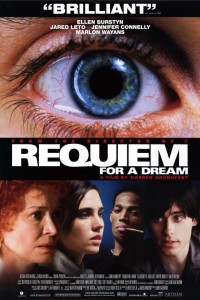 In The 40-Year-Old Critic, Venganza Media creator and host Arnie Carvalho recalls a memorable film for each year of his life. This series appears daily on the Venganza Media Gazette.
In The 40-Year-Old Critic, Venganza Media creator and host Arnie Carvalho recalls a memorable film for each year of his life. This series appears daily on the Venganza Media Gazette.
Have you ever seen a film that you instantly loved, but never wanted to see again? That was my reaction to seeing Requiem for a Dream in 2000.
I was drawn in by director Darren Aronofsky. I had seen his first film, the black-and-white techno thriller Pi, and was enthralled. The use of music, the sophisticated themes, the weird camera angles, the ideas of patterns in everything in life, the repeated sequences that formed a pattern in a movie itself about patterns; all of it left me entranced. I instantly knew Aronofsky was a talent to watch.
I anxiously awaited Requiem’s release, my excitement growing as I read high praise coming out of its screening at the Cannes Film Festival. Being a small film ($4.5M budget) with a very non-commercial NC-17 rating, I knew Requiem would not get a wide release. Sure enough, the picture opened on just 93 screens.
Like a character in an Aronofsky film, I was obsessed with seeing this movie. As such I made plans to visit my Now Playing Podcast co-host Stuart in Chicago, and there we would go see Requiem together.
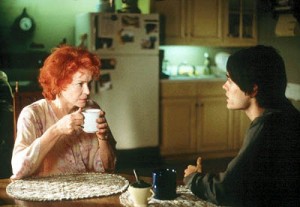
Burstyn and Leto share a rare scene together in Requiem for a Dream.
Based on the novel of the same name by Hubert Selby, Jr., the film follows nine months in the lives of Harry Goldfarb (Jared Leto) and his mother Sara (Ellen Burstyn). Despite the familial relation, the two characters rarely interact; their stories run parallel as we follow their hopes and falls. Starting in “Summer” and ending in “Winter”, the falling temperatures also represent the decline in the characters’ fortunes.
Harry is a heroin addict. He and his friend Tyrone (Marlon Wayans) have hit bottom so many times that stealing Sara’s television to pawn for drug money has become routine. After one theft, followed by a good high at the beginning of the film, Tyrone starts to show ambition –rather than just shooting up, the friends decide to resell some of their drugs to double their money. They have career aspirations of someday dealing a full pound of pure heroin that would set them up for a long time and allow Tyrone to move out of his bad neighborhood.
They start their plan — taking regular pauses to shoot up — and things start to go well. Harry even earns enough money to try to make amends with his mother, and buys her a new, modern television.
In addition to Harry’s burgeoning career as a drug dealer, he is madly in love with girlfriend and fellow junkie, Marion (Jennifer Connelly). The two dream of using their drug money to open a clothing store, allowing Marion to escape her controlling parents. With his money and his girl, things look great for Harry.
Sara, meanwhile, is also finding success. When the film begins she is an elderly widow living alone in an apartment, with little to do but watch self-help television shows. One day her fortune changes with a single phone call: she has been selected to be on her favorite game show. Sara is beyond excited, but also nervous about appearing on national television. A neighbor helps her dye her hair, with unfortunate results. She’s even more distressed after finding out the red dress she wants to wear on the show — one her late husband loved — no longer fits.

Sara starts popping the pills faster and faster to fit in that red dress.
After attempts at crash dieting prove unsuccessful, Sara visits a doctor and begins taking a heavy dose of diet pills. The amphetamines have severe side effects — Sara starts to grind her teeth and can’t sit still — but she loses 25 pounds and feels great. Her looming television appearance has made her the superstar among the retirees in her apartment building and she’s soaking it up.
When Harry brings his mother the new television he instantly knows Sara is tweaking on uppers. He tries to get her to stop, but she is too excited for the game show; even though her obsessive checking the mail for information about her appearance has yielded no results.
If you haven’t seen Requiem for a Dream, if you’ve only read the description above, you might think this is an ugly movie about despicable people. A heroin addict who steals from his own mother? A lonely old woman obsessed with television? A junkie aspiring to become a dealer? In so many movies these characters would be the villains, or at least the antagonists. But Aronofsky is a deft storyteller, and slowly he makes us care for each person on the screen.
Every character is given a touching moment. For Harry and Marion, it’s them lying in bed expressing their affection for each other. They don’t just say “I love you” — rather Harry uses the trite expression, “You’re the most beautiful girl I’ve ever seen.” She responds, telling him she’s heard that a lot, but adds that when Harry tells her it truly has meaning.
More than words, we see that scene through the points of view of both characters via split-screen, allowing for close-ups of Leto and Connelly. This unique approach drives home multiple points: a) they’re together, yet not, b) it’s the first sign that something will come between them, and c) the close-up shots convey intimacy, not isolation.
Then the shots get more inventive. We see Harry talk on one side of the screen, and on the other we see his hand caressing Marion, his thumb brushing over her lips, her palm. Then we see her close-up, and her hands on him. It’s not a sex scene, but this communion between two characters shows their relationship in a much more intimate setting. After only two minutes you want these kids to make it, yet their addiction hangs like a storm cloud.
The same goes for Harry and his mother. While he starts by stealing her television, causing Sara to lock herself in a closet away from her son, he still tries to assure her that everything will be okay. Later in “Summer” we see Harry and Marion on the beach, the man verbalizing how much he loves and cares for his mother and how, now that he has money, he wants to make right every wrong he’s done. It’s a deft turn, but thanks to Leto’s performance and earnest language, Aronofsky has made this thieving drug abuser actually seem noble and good.
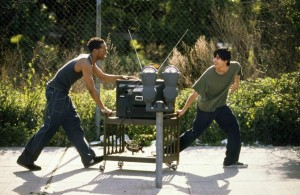
Harry and Tyrone take in some TV.
Tyrone is given the least background of the four, an odd choice considering he is the lead drug dealer. His girlfriend is never named, and his backstory is limited to a bit about honoring his dead mother. Still, Wayans gives a career-best performance in a rare, non-comedic role for the Scary Movie actor. Much of this is due to Aronofsky’s editing — one needs only to watch the deleted scenes on the DVD to realize Wayans tried multiple approaches to Tyrone, including a full-on Jar Jar Binks impersonation.
As shown on screen, Tyrone is the least developed character, yet still a likable personality thanks to the heart Wayans puts into the role.
It’s actually astounding that Requiem makes drug dealing seem like a bright, hopeful career path.
As for Sara, this character may not be one you hate, but one you pity. A virtual shut-in with a television obsession, it is again the script and the actress that makes Sara sympathetic instead of just pathetic. When Harry comes to tell his mother about the new television he asks why she cares so much about the game show appearance.
She responds at first by pointing out to Harry the reverential treatment she has been getting from the other biddies in her building:
“I’m somebody now, Harry. Everybody likes me. Soon, millions of people will see me and they’ll all like me. I’ll tell them about you, and your father, how good he was to us. Remember?”
Then after a pause, an even sadder truth comes out — this television show is all she has to live for.
“It’s a reason to get up in the morning. It’s a reason to lose weight, to fit in the red dress. It’s a reason to smile. It makes tomorrow all right. What have I got, Harry? Why should I even make the bed or wash the dishes? I do them, but why should I? I’m alone. Your father’s gone. You’re gone. I’ve got no one to care for. What have I got, Harry? I’m lonely. I’m old.”
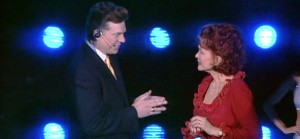
Sara hallucinates a visit to her favorite TV show, hosted by Tappy Tibbons (Christopher McDonald in a memorable minor role).
The obvious answer is right there: Harry could pay more attention to his mother. What she really needs isn’t another television, it’s human connection. But while Harry is desperately trying to be a good son he’s exacerbating his mother’s issue by allowing her to submerge deeper into television, versus helping her to escape it. Despite seeing his mother’s obvious bad reaction to the uppers, this is the last time Harry sees her.
Even with the obvious, unspoken truth of the scene, the monologue could have fallen flat if not for Burstyn’s amazing performance. She jitters while she plays the scene, expressing her agitation from the pills, with a nervousness at being so honest with anyone. She says the lines with a smile, but the sadness comes through in the delivery. Burstyn deserves every accolade she was given for this performance.
Finally, the mood is lightened with humor. When Harry and Tyrone steal the television it’s a joy watching them wheel it past all of Sara’s neighbors, who are more concerned with soaking up the afternoon sun than they are the obvious and strange theft. The characters laugh, joke, and keep the film from becoming too morose.
The combination of the amazing director, actors, and screenplay prevent this story from feeling trite or ugly. When “Summer” ends I was rooting for all four characters to achieve their dreams.
But if that was the summer, soon must come the fall, literally and metaphorically.
For Sara, this comes from her body building up a resistance to the amphetamines. She no longer gets her high from the pills, and though her red dress nearly fits, she needs to continue losing weight. When the doctor won’t up the dosage she self-medicates, taking multiple pills at once.
For Harry, Marion, and Tyrone, their downfall begins when a drug war breaks out in the city. Supplies of heroin have dried up — they can’t get any more to sell, and they can’t get any more to take. Their relationships are stressed, especially by Marion, who seems to suffer the worst withdrawal and blames Harry for her inability to shoot up.
By the time the film gets to “Winter” the movie is no longer a dark comedy. Each character becomes more desperate, and their ends are each so awful that Requiem for a Dream practically becomes a horror film. Yet none of it would work had we not cared for the characters — we would have applauded horrible people getting their just desserts. That I love these people and don’t want to see their ruination is the result of successful, manipulative storytelling of the best possible sort. Aronofsky made me like them, then pulled the rug out from under them — he did the same to us in the audience.

When I left the theater I was shaken and sad. The ending was depressing, but it was just; and I realized that. I felt as mournful as I would for a friend who’d gone down a bad road. This movie was hard — hard to watch, hard on its characters, and hard on the audience. I left the theater knowing I loved every frame of this film but also thinking it was such an emotional trial that I never wanted to watch it again.
I did though, many times. Beyond just great storytelling, Requiem for a Dream is a visual masterpiece that I — after some time passed — wanted to revisit to fully take in.
Aronofsky’s second feature brought back so many of the things I’d enjoyed in Pi, especially the inventive, experimental camerawork. Now, more than a decade later in a time when GoPro cameras are strapped to everyone’s heads, you see the genius in Aronofsky’s self-proclamed “Schnoz cam” — strapping the camera to an actor so the person always stays in the center of the frame while the background and scenery move around them. First used in Pi and then in Requiem, this gave the feeling of a character surrounded by a world out of control — a sign of madness, or a visual representation of vertigo. When sped up film footage is added to the effect, you see that Aronofsky created an entirely new way to deliver the same emotion as the old Hitchcockian “push and pull” change of depth.
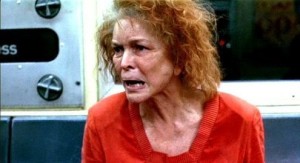
Sara finally fit in her red dress, but at what cost?
One of the things that impressed me about Pi was its unique visual style. Despite being very low budget, the use of superimposed images, quick cutting, and repetition was hypnotic. That is also on full display in Requiem. Every time the characters get high, be it by snorting, shooting up, or popping pills, a ritual is performed. The film cuts to a montage that lasts only seconds but shows the actions, and the characters. A lighter is lit, drugs boil, a syringe fills, blood courses through veins, pupils dilate. It all happens so fast that it’s virtually subliminal, yet it tells us everything we need to know. As the film becomes more desperate the montages are even faster, showing us people stuck in a cycle of self-destruction.
Aronofsky also isn’t afraid to get surreal. In the depths of psychosis Sara sees cupcakes floating in the air, her favorite self-help TV personality appears in her living room, interlaced at her television’s 480 lines of resolution. At one point her refrigerator even opens a gaping maw to eat her. These types of shots could undermine the mood but, as done here, they just enhance it.
In addition to the camerawork, enough credit simply cannot be given to composer Clint Mansell. I had the CD from Pi, his first film score, on an endless loop in my car; the electronic techno score was perfect for that film about a computer programmer, but I never would have thought the composer could hit the emotional resonance he did when he reteamed with Aronofsky for Requiem.
As this was a low-budget film, the score was performed by just four people: The Kronos Quartet. Still, with just violins, a viola, and a cello this score permeates nearly every frame of the movie. The low, sonorous tones of the cello dominate and make even the happy scenes foreboding. It’s a gorgeous composition that feels so classical it’s impossible to believe it was written in the 21st century; it feels like the work of Edvard Grieg, or one of Beethoven’s darker works.
The score has such an emotional resonance that it has been the breakout star of Requiem for a Dream; even if you’ve not seen this film I guarantee you’ve heard the score’s climactic movement, “Lux Aeterna.” Just two years later, in 2002, my jaw hit the floor when the trailer for Peter Jackson’s The Lord of the Rings: The Two Towers was scored to an orchestral version of “Lux Aeterna” — the assemblage of instruments and a faster tempo giving the song a more epic feel than the Quartet did alone (This orchestral version is available for digital purchase at Amazon).
In the years since, “Lux Aeterna” has been a go-to track for movie trailers, including Zathura, I Am Legend, Sunshine, The Da Vinci Code and, unlikely as it may seem, it was even used in Barbie doll ads!
Combined, every element of this film comes together as smoothly as one of Harry’s heroin montages. More, the performances, cinematography, and soundtrack all underscore the film’s thesis — summed up in the title — about the lengths to which people go to try and achieve their dreams. No matter what your dream, be it to be a TV star, a clothing shop owner, a screenwriter, or a podcaster, it’s a plight to which everyone can relate.
Aronofsky finally achieved mainstream success and acclaim with 2008’s The Wrestler, and then went on to even greater success with 2010’s Black Swan. I consider that unfortunate. While I like both of those films, the director has never achieved a more perfect theatrical representation of obsession than he did with Requiem for a Dream. And though I’ve yet to see this year’s Noah, my feeling is Requiem is Aronofsky’s best film to date.
Even if I do have to steel myself every time I rewatch it.
Tomorrow — 2001!
Arnie is a movie critic for Now Playing Podcast, a book reviewer for the Books & Nachos podcast, and co-host of the collecting podcasts Star Wars Action News and Marvelicious Toys. You can follow him on Twitter @thearniec

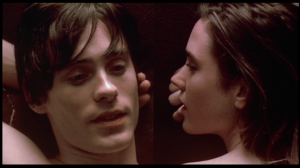
Arnie, have you seen Protozoa from Aronofsky? Love the series. Big fan.
I too shared in the experience.
Loved the film upon first viewing, but felt dirty, surreal and disconnected with society.
I walked through the mall for hours after to help reconnect.
It was a film I wanted to recommend to people, with heavy disclaimers. Mostly, if the film freaks you out or the material is inappropriate, don’t comeback against me.